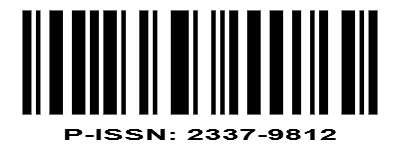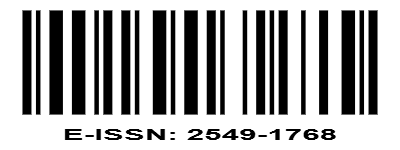IDENTIFICATION OF STARCH FORMS IN EDIBLE PLANTS
DOI:
https://doi.org/10.22373/biotik.v10i2.13516Keywords:
Edible Plants, Starch FormAbstract
This study aims to identify the forms of starch in edible plants. This research involved several edible plants such as sago, yam and taro. This type of research uses descriptive quantitative methods by conducting experiments on each sample used. The data collection technique was carried out by describing the results of the starch form from each sample that had been obtained. The results obtained from this study showed that the Sago preparations viewed under a microscope had an oval starch shape and spread throughout the preparation so that it was classified as an eccentric starch type that could be seen at 10X magnification, while Jicama starch preparations had a round starch shape and chains in some parts. The plane of the preparation and entered in the concentric type, but the shape of starch in Jicama can be seen under a microscope at 100X magnification, the Taro preparation has a round and lumpy shape but the starch accumulates in several areas of the preparation and enters the concentric type seen at 40X magnification. So it can be concluded that the forms of starch in edible plants are very diverse, both in round to oval shapes, with smooth and rough starch structures, namely in the form of lumps.
Keywords: Edible Plants, Starch Form
Downloads
References
Utami, S. (2017). Keanekaragaman Tumbuhan yang Berpotensi sebagai Bahan Pangan di Hutan Lindung Pulau Panjang Jepara Jawa Tengah. Jurnal Bioma, 19(2), 136-140.
Prabaningrum. H., Nugroho, A.,S dan Kaswinarni, F. (2018). Keanekaragaman tumbuhan yang berpotensi sebagai bahan pangan di cagar alam gebugan Semarang. Jurnal Biologi dan Pembelajarannya, 5(2) 26-31.
Maryanto, I., J.R. Rahajoe, S.S. Munawar, W. Dwiyanto, D. Asikin, S.R. Arianti, Y. Sunarya & D. Susiloningsih. 2013. Bioresources untuk pembangunan ekonomi hijau. LIPIPress. Jakarta
Kumalawati, H., Izzati, M., dan Suedy, S., W., A., 2018. Bentuk, Tipe dan Ukuran Amilum Umbi Gadung, Gembili, Ubi Ungu, Porang dan Rimpang Ganyong. Buletin Anatomi dan Fisiologi (Bulletin Of Anatomy and Phsiology), 3 (1), 56-61
Misnawati. 2015. Studi Pembuatan Edible Film dari Proporsi Karagenan-Kitosan dan Penambahan Larutan Pati Kimpul. Skripsi. Fakultas Pertanian Peternakan. UMM. Malang.
Keshav, A., Sharma, A. and Mazumdar, B. (2019) Phytochemical Analysis and Antioxidant Activity of Colocasia esculenta (L). Leaves' International Journal of Chemical and Molecular Engineering, 13(1), pp. 20 23
Wati, Karmila. 2014. Identifikasi Amilum Secara Kimiawi dan Mikroskopis. Kendari: Jurusan Farmasi Universitas Haluoleo.
Sutrian, Y. 2011. Pengantar Anatomi Tumbuh-tumbuhan: Sel dan Jaringan. Rineka Cipta, Jakarta.
Hariyanto, B., 2011. Manfaat Tanaman Sagu (Metroxylon sp) Dalam Penyediaan Pangan dan Dalam Pengendalian Kualitas Lingkungan. J. Tek. Ling, 12 (2), pp. 143-152.
Sakiynah, Ni’mah. Tigor, Ralibi, Achmad & Setyawan Heru. Desain Pabrik Pengolahan Tepung Sagu. JURNAL TEKNIK POMITS Vol. 2, No. 1, 2013.
Syakir, M. & Karmawati, E. 2013. Potensi Tanaman Sagu (Metroxylon spp.) Sebagai Bahan Baku Bioenergi. Perspektif Vol. 12 No. 2/desember 2013. Hlm 57-64
Sri Mulyani. 2019. Anatomi Tumbuhan. PENERBIT PT KANISIUS. Yogyakarta
Nurbaya, Syarifa Ramadhani, “Pemamfaatan Talas Berdaging Kuning (Colocasia esculenta(L.) Schott) Dalam Pembuatan Cookies”. Jurnal Pangan dan Agroindustri 1 no. 1 (2013).
Amin, Jaksen M. dan Empayus. “Faktor Ragi Roti Dan Waktu Fermentasi Tepung Umbi Talas (Colocasia Esculenta (L.) Schott) Menjadi Bioethanol”. Prosiding Seminar Nasional Lahan Suboptimal. 2014.
Wahyuni, Sri. T. 2010. Pembuatan Dekstrin dari Umbi Talas dengan Hidrolisis Secara Enzimatis (Skripsi). Surabaya: Universitas Pembangunan Nasional “Veteran” Jawa Timur.
Hidayat, R., Mulyadi, S., dan Handayani, S. 2015. Pengaruh Penambahan Pati Talas Terhadap Sifat Mekanik dan Sifat Biodegradabel Plastik Campuran Polipropilena dan Gula Jagung. Jurnal Fisika Unand 4 (3) : 271
Downloads
Published
Issue
Section
License
Copyright (c) 2022 Susi Mulianti Lubis, Tri Mustika Sarjani

This work is licensed under a Creative Commons Attribution-ShareAlike 4.0 International License.
Authors who publish with BIOTIK: Jurnal Ilmiah Biologi Teknologi dan Kependidikan agree to the following terms:
- Authors retain copyright and grant the journal right of first publication with the work simultaneously licensed under a Creative Commons Attribution License that allows others to share the work with an acknowledgement of the work's authorship and initial publication in this journal.
- Authors are able to enter into separate, additional contractual arrangements for the non-exclusive distribution of the journal's published version of the work (e.g., post it to an institutional repository or publish it in a book), with an acknowledgement of its initial publication in this journal.
- Authors are permitted and encouraged to post their work online (e.g., in institutional repositories or on their website) prior to and during the submission process, as it can lead to productive exchanges, as well as earlier and greater citation of published work.











